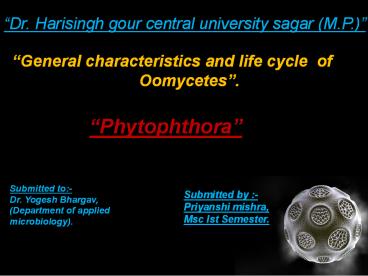Phytophthora - PowerPoint PPT Presentation
Title:
Phytophthora
Description:
Phytophthora fungi – PowerPoint PPT presentation
Number of Views:56
Updated: 4 June 2021
Slides: 16
Provided by:
Priyanshi mishra
Category:
Medicine, Science & Technology
Tags:
Title: Phytophthora
1
Dr. Harisingh gour central university sagar
(M.P.)
General characteristics and life cycle of
Oomycetes.
Phytophthora
Submitted to- Dr. Yogesh Bhargav, (Department of
applied microbiology).
Submitted by - Priyanshi mishra, Msc Ist
Semester.
2
Oomycetes
- Cellulose walled fungi.
- Consist of Four orders-
- Saprolegniales (freshwater saprotrophs, eg.
Achlya, saprolegnia). - Leptomitales (Fermentative aquatic fungi),
- Lagenidales (plant root parasites),
- Perenosporales (plant pathogens).
- Contain 74 genera with 580 species.
- Aquatic,
- Mode of nutrition Free living (Saprophytic) or
parasitic. - Habitat most members are aquatic but some grow
on soil and other attack shoot of terrestrial
plants. - Primitive forms are unicellular, advanced forms
are branched, filamentous and coenocytic
mycelium. - Cell wall composed of cellulose-beta-glucan and
chitin is altogether absent. - Asexual reproduction takes place by pyriform and
reniform. - Sexual reproduction is oogamous type.
- Many members helps to understand evolutionary
migration of fungi from aquatic to terrestrial. - Causes plant diseases.
3
Phytophthora
Greek phyton plant, Thora destruction. (Plant
destroyer)
- Genus first described by Heinrich Anton de bary
in 1875. - Genus is cosmopolitan.
- Wider host range.
- Eg. P. Cactorum recorded over 200 species and
60 families of flowering plants - p. Cinnamon 1000 plants causes several
disease especially on woody hosts. - Phytophthora are pathogenic to dicotylednous
crop. - Differ merely in extent to which they have free
living saprotrophic phase. - May survive in soil atleast in the form of
oospores, or in infected host tissue. - All Pathogenic forms isolated from host and can
be grown in pure culture. - Selective media, often incorporating antibiotics
or fungicide such as pimaricin or benomyl, have
been devised for isolation of phytophthora. - Most destructive in low temperature and high
humidity.
4
General characteristics
- Facultative parasites,
- Eucarpic thallus,
- Mycelium is well developed, filamentous branched
(right angle),Coenocytic (aseptate), healing,
intercellular with haustoria Mycelium. - Cell wall primarily composed of cellulose.
5
Classification
- Kingdom mycota,
- Phylum oomyceta,
- Class oomycetes,
- Order Perosporales,
- Family phythiaceae,
- Genus phytophthora,
- Species infestans,
- colocasiae,
- Parasitica.
6
Vegetative structure
- Mycelium is coenocytic aseptate, healing and
monopodial branching. - Septa formed at the time of reproduction or at
maturity. - The cell wall consist of glucan, chitin is
however absent. - Cytoplasm contains many nuclei, mitochondria,
endoplasmic reticulum, ribosome, dictyosomes,
vacuoles and many oil globules. - The mycelium is intracellular and directly kills
invaded cells. In some cases it is intercellular. - Haustoria developes as lateral outgrowth from the
intercellular hyphae. - Cytoplasm of haustoria contains mitochondria,
ribosome, endoplasmic reticulum and nuclei.
7
Life cycle
Three mechanism of life cycle
Vegetative reproduction
Asexual reproduction
Sexual Reproduction
8
Vegetative reproduction
- Many species of pythophthora (P.colocasiae and P.
Parasitica) reproduce by chlamydospores. - Chlamydospores may be terminal or internally.
- They germinate by giving rise to 3-11 germ tubes
which generally develop sporangia at their tip.
9
Asexual cycle
10
Cont
11
Sexual cycle
12
Graphical life cycle
13
Disease caused
- Most species of phytophthora are soil borne plant
pathogens causing disease of both herbaceous and
woody mostly dicotylednous plant. Example Root
rot, basal stem rot, leaf spot or blight as well
as fruit rot.
- Phytophthora citricola Root rot and stem cancers
in citrus trees, - Phytophthora fregariae Red root rot affecting
strawberries, - Phytophthora infestans potato late blight
- Phytophthora palmivora Fruit rot of coconut and
betel nuts, - Phytophthora ramorum sudden oak death,
- Phytophthora sajae soybean root rot,
- Phytophthora colocasiae colocasia blight ,
- Phytophthora nicotianae Black shank disease of
tobacco, - Phytophthora cactorum bud rot of coconut,
- Phytophthora arecae seedling blight of areca
nuts, - Phytophthora erythrosepica pink rot of potato.
14
Symptoms of disease caused by phytophthora
- The disease appears as small black or purplish
black areas at margins and tip of leaf. - These patches gradually enlarge under favorable
conditions. All part of host undergo browning and
rotting. - If the soil is very moist, tubers are also
affected and may rot completely. - In colocasia, large, circular, ovular irregular
yellowish brown areas appear on leaves. Drops of
a yellow liquid oozes out from the leaf surface,
rotten of corms results in severe infection.
Control of phytophthora
- Cultivation of resistant varieties.
- Spraying of fungicide like Bordeaux mixture.
- Destruction of infected foliage by Spraying with
sulphuric acid, copper sulphuric, dithane and
Fytolan. - Seed tubers should be obtained from areas where
disease does not occur. - Tubers should be covered with a thick layer of
soil. It will avoid the chances of spores coming
in contact with them. - Good drainage system should be maintained.
15
(No Transcript)































